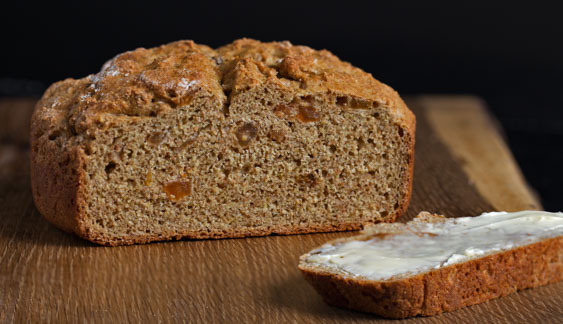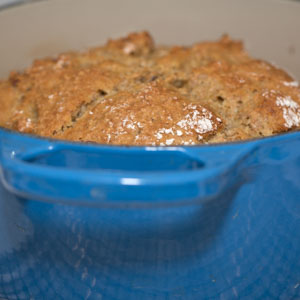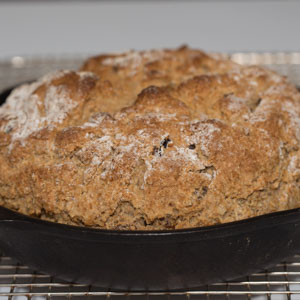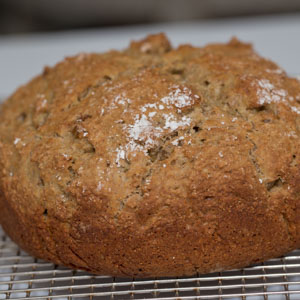Irish Soda Bread

introduction
We always thought Irish soda bread was a sweet golden-hued boule with raisins and caraway seeds, leavened with soda, and baked for St. Patrick’s Day. We thought it had white flour, butter, maybe an egg, and some buttermilk. It turns out recipes like this make a lot of Irish people really mad. Classic soda bread, an ancient poor man’s staple, is about as far from feast bread as it gets: it bears no butter, eggs, sugar, raisins, or caraway seeds. Frequently produced entirely from whole grain flour, real Irish soda bread is a sober, non-frivolous repast. Sober but not dour. Heavy but not dry. Flour, soda, salt, and buttermilk. If the entire enterprise sounds like a no-frills, why-bother waste of time, let us assure you, it is not.
We immediately replaced half of the Fine Cloth-Bolted Pastry Flour we’d been considering with Anson Mills’ spectacular graham flour, and then began working on the proportion of buttermilk. Without butter, a quick bread, given half the chance, will bake to full door stopper. To avoid this, the dough must be well-hydrated and under-handled. The quantity of buttermilk went up, up, up.
Today’s soda bread doughs are generally stout enough to be free-formed and baked on a sheet pan or in a black skillet. But originally the bread was placed in a three-legged Dutch oven in live coals, its lid smothered with additional coals. This is a brilliant notion in a couple of respects. First of all, a slack dough begs for walls for support. Secondly, the closed environment of a Dutch oven traps the steam released by the loaf, thereby keeping its surface moist and supple, which allows the dough to expand as it bakes. When the steam burns off, the bread develops a superb crust.
And, thus, after a number of miscarriages, our bread was conceived and delivered in a covered Dutch oven.
What a fine, moist, rugged country bread it is! Deep nuttiness, faint fruit, and a satisfying array of toasted whole bran and chisel flavors emerge from handmade whole grain rustic graham flour, while pastry flour lightens the bread’s texture and flavors the crumb with a faux butteriness. The crust is thin but crisp. Oh, and just so you know, we sneaked a half cup of black tea–infused golden raisins—and a little shhhh of sugar—into the formula. The raisins perform a charming little jig here and there—delicious and surprising. The sugar is a mere trace element for flavor roundness. Do us a favor and don’t tell anyone from Ireland—or, if you prefer, leave the two interlopers out of the formula altogether.
Baking Notes
Take the old baking soda you have, put it in the fridge, and splurge on a new box to bake with. The soda for this bread must be fresh and well distributed—it’s not getting any extra help from baking powder. It is partly for this reason that we ask the pastry flour, soda, and salt to be sifted. Once the dough is mixed, work quickly to get the shaggy mass into the oven.
If you don’t have a small Dutch oven, bake the bread in an 8-inch cast-iron skillet. The crust will be thicker, but the crumb will be fine. If you are baking in a Le Creuset Dutch oven with black handle on its lid, be sure to protect the knob from the heat by wrapping it with aluminum foil.
equipment mise en place
For this recipe, you will need a digital kitchen scale; a small bowl; a 2-quart enameled cast-iron or regular cast-iron Dutch oven, or an 8-inch cast-iron skillet; a fine-mesh strainer; a large mixing bowl; a whisk; a rubber spatula; a plastic dough scraper; a sharp paring knife; an instant-read thermometer; a wire rack; a clean tea towel; and a spray bottle filled with water.
-
-
2.5ounces golden raisins
-
4ounces hot strong black tea
-
2teaspoons unsalted butter, room temperature
-
7ounces Anson Mills Colonial Style Fine Cloth-Bolted Pastry Flour, plus additional for the work surface
-
1teaspoon baking soda
-
¾teaspoon fine sea salt
-
7
-
1tablespoon sugar
-
11ounces buttermilk, room temperature
-
-
In a small bowl, combine the raisins and tea and set aside. Adjust an oven rack to the lower-middle position and heat the oven to 450 degrees. Coat the inside of a 2-quart enameled cast-iron or regular cast-iron Dutch oven, or an 8-inch cast-iron skillet, with the butter and set aside. If you are baking in a Le Creuset Dutch oven with black handle on its lid, wrap the just the knob with aluminum foil.
-
Turn the pastry flour, baking soda, and salt into a fine-mesh strainer set over a large mixing bowl and sift the ingredients into the bowl. Add the graham flour and sugar and whisk well to combine.
-
Flour a clean work surface. Drain the raisins, shake them dry, and toss them into the dry ingredients with your fingertips. Make a well in the dry ingredients and pour the buttermilk into it. Using a rubber spatula, lightly and quickly fold the wet ingredients into the dry. As soon as the dry ingredients are evenly moistened (fig. 3.1), use a plastic dough scraper to turn the dough out onto the floured work surface. Flour your hands, shape the dough into a round about 5 inches wide at the base, and quickly transfer it to the prepared baking vessel. Using a sharp paring knife, score a ½-inch-deep cross into the dough (fig. 3.2), cover if using a Dutch oven, and slide into the oven. If using a Dutch oven, bake for 20 minutes, lower the oven temperature to 400 degrees, and continue to bake until the bread is lofted and brown (fig. 3.3) and tests 190 degrees on an instant-read thermometer, about 20 minutes more. If using a skillet, bake for 15 minutes, lower the oven temperature to 400 degrees, and continue to bake until the bread is well risen and brown (fig. 3.4) and an instant-read thermometer shows 190 degrees, about 20 minutes more.
-
Turn the bread out onto a wire rack (fig. 4.1) and drape it with a clean tea towel. With a spray bottle filled with water, lightly mist the towel with water and let the bread cool completely—but then gobble it up fast with plenty of butter. Irish soda bread makes phenomenal toast and may be wrapped in plastic and then foil and frozen for up to 2 months.
-
-
3.1

-
3.2

-
3.3

-
3.4

-
-
-
4.1

-